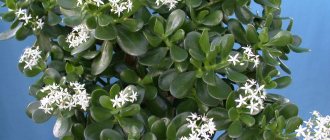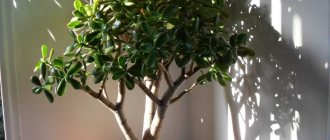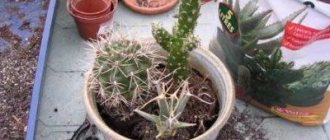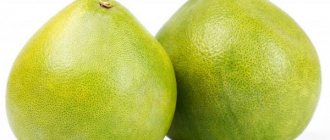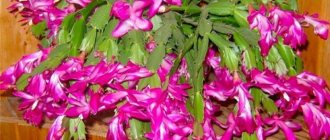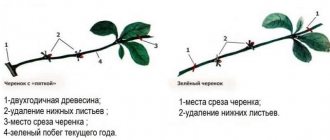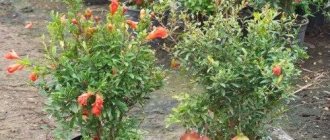How does a money tree propagate at home?
Gardeners can propagate Crassula from a leaf or cutting. If everything is done correctly, there will be no difficulties. The seed method is used by breeders because it requires more time, certain knowledge, and the result is unpredictable.
How do you propagate Crassula?
Cuttings
37.5%
Leaf
62.5%
Vegetative propagation is the cloning of a plant; the seeds of the crassula produce splitting.
Cuttings
Any shoots are suitable for propagation - from young, thin apical shoots to old and thick ones. Depending on how many new plants the owners want to get, and whether they need a large specimen, large branches can be planted whole or from cuttings.
If handled correctly, any pieces of Crassula will take root well; they do not necessarily have to be 10-15 cm wide and have at least 3 internodes.
Large cuttings are actually adult plants without roots; they can be trimmed or left as is, depending on the wishes of the owners. It is important that the large branch does not turn out of the pot, and that the pot itself does not fall under the weight of the fat plant.
The apical cuttings grow vertically and develop as a full-fledged plant. They are also planted in individual containers; when a new leaf appears, they are cared for like an adult specimen.
It’s another matter if the fat plant propagates by cuttings taken from the middle part or base of the shoot. They take root well, but it is impossible to predict whether they will produce one sprout that replaces the top, or several lateral ones. Often such branches are placed in a common seedling container, and after rooting, 2-3 pieces are planted in pots. In the next season after breeding, these will be pretty bushes or trees. The owners will only have to adjust the crown.
You can also germinate Crassula in water. To do this, the cuttings must really have several internodes and a length of at least 10 cm, otherwise they will rot.
Leaves
It is as easy to obtain a money tree from a leaf as when propagated by cuttings. Even an accidentally broken plate, falling on the ground, often sprouts roots, but it does not always produce a sprout, especially when the flower is often watered.
Crassula develops from a leaf slowly; it will look like a full-fledged plant in a few years; such propagation requires patience. It is better to root the plates in the substrate, since they easily rot in water, and when subsequently transplanted into the ground they suffer more than cuttings.
It is interesting that even experienced cactus growers cannot predict how many children the leaf will produce - one, several, or simply rot or dry out without producing offspring.
When the daughter rosettes reach a height of 1-2 cm, they are separated from the mother leaf and planted in containers with a diameter of 5-7 cm. Beginning gardeners can wait until the children grow up - this will delay development a little, but the likelihood of survival will increase.
Seeds
Seed propagation of Crassula is of interest to breeders; it is usually used by amateurs when a species or variety cannot be obtained in any other way. Algorithm:
- Fill a wide, low bowl with holes in the bottom with a 2:1 mixture of leaf soil and sand.
- Lightly crush and level.
- The seeds are sown. Cover with a 5 mm layer of soil.
- Moisten with warm water from a spray bottle.
- Cover with glass or transparent film.
- Keep at a temperature of about 25° C.
- Ventilate daily and remove condensation.
- The substrate should be slightly damp, but not wet.
- In about 2 weeks, shoots will appear.
- As soon as the seedlings grow a little, they are dropped into a box filled with a mixture of sand, turf and leaf soil (1: 1: 2).
- Keep in a bright place without direct rays, water carefully.
- When the sprouts reach 2-3 cm, dive a second time into pots or plastic cups with a diameter of 5-7 cm into a mixture of cactus soil and sand (2:1).
Features of the Crassula
Crassula, Crassula or money tree
Crassula, or scientifically Crassula, is commonly called the coin tree, but more often the money tree for the clear resemblance of small, round and shiny leaf blades to coins. This succulent plant, belonging to the extensive Crassulaceae family, is extremely widespread in the wild, but is most often found in the Southern Hemisphere. Only a few species are used in indoor floriculture.
A short (up to 0.5 m) evergreen tree with one or several thickened trunks has a dense crown, the branches of which are densely strewn with smooth and elastic leaves (4 to 7 cm in diameter) of a rich dark green hue. A young Crassula has a delicate, greenish bark; with age, its color changes to grayish-brown. The care and maintenance of this crop at home has some features:
- Excess moisture is detrimental to Crassula. When overmoistened, the root system rots, the foliage becomes covered with brownish-brownish spots and crumbles;
- The plant is light-loving; it is preferable to keep it on windowsills facing the south and west. However, direct burning rays of the sun leave disfiguring burns on the fleshy leaves, so in summer the flower needs to be shaded a little;
- Crassula does not tolerate heavy, very moisture-intensive and poorly drained soils. It is necessary to select specialized substrates intended for succulents;
- since under natural conditions this crop grows on poor lands, frequent feeding is harmful for it;
- crown formation, which involves timely pinching of fresh shoots, is mandatory for a money tree, since this procedure stimulates the active growth of above-ground green mass.
How to take a cutting from a money tree
To propagate Crassula, leaves and small twigs can be cut off or plucked off. A thick shoot must be separated with a sharp blade. Hands must be clean and instruments sterile.
You can take a cutting for propagation from any part; if you need a lot of plants, it is recommended to divide long ones into pieces with one or several pairs of leaves. The lower cut should be approximately 5 mm below, and the upper cut above the internode.
The plates located below are removed so that they do not end up in the ground or under water. They can also be used for reproduction.
The leaves are easy to pinch off with your fingernails; when trimmed, a column usually remains. It is not recommended to break them off - the epidermis from the branch may be pulled behind the plate, and the fat plant will receive unnecessary injury.
You need to take leaves from the middle or base of mature shoots located in the center of the bush. The lower ones of an adult plant are old, have finished their life, are ready to dry out, and are unlikely to produce children, even if they take root.
Those located at the tops of the branches are too young and have not yet finished developing. When planted in a substrate, they, like violets, will first take root, continue their own growth, and only then produce daughter rosettes. If they don't disappear first.
Caring for young plants
Crassula: propagation by cuttings
Further care for young Crassulas consists of the following steps:
- moisten carefully and very moderately (the top layer of the substrate in the planting container must dry completely). In spring and summer, once every 5-7 days; in the cold period, once every 10-15 days is enough;
- fertilize no more than once a month (spring and summer), using highly specialized fertilizers for succulent crops. In winter, fertilizers are not required;
- Adult fat plants are transplanted as needed (roots have sprouted through the drainage holes). For young bushes, the planting containers should be changed annually, because they grow quite quickly;
- form a crown by pinching out too long shoots;
- ventilate the room, letting in fresh air. In summer, take the money tree to the balcony, loggia or terrace;
- wipe the leaves with a damp cloth or wash them in the shower;
- loosen the substrate in the pot, preventing the formation of a hardened earthen crust.
How to root a Crassula shoot
Propagation by cuttings or leaves is a simple operation and can be carried out in different ways. Rooting in water is allowed, but professional cactus growers prefer planting in a light substrate, and when they do not have enough space, they germinate the money tree in the air.
Using stimulants for Crassula does not make sense. Its vegetative organs contain enough growth hormones so that the juice accelerates root formation in other crops.
In the ground
When propagating Crassula, it is recommended not just to dry sections of leaves or shoots until callus forms, but to wither them. Only when they lose turgor, most of the moisture leaves, will the money tree receive an incentive to form new roots.
After drying, the sections are treated with a fungicide or crushed activated carbon. Leaves or cuttings are planted in soil for succulents, mixed 1:1 with baking powder. Of those that are easiest to obtain, it is better to use perlite or crushed expanded clay rather than sand.
Landing algorithm:
- Containers 5-7 cm in diameter with bottom holes are filled with substrate.
- Knead slightly so that the cuttings or leaves do not fall through when watering.
- Make a small hole with a stick.
- The branch is placed vertically, the plate - at an angle or almost horizontally.
- Water with warm water. The substrate needs to be wetted not completely, to the bottom, but to the depth of the underground part of the fat plant.
- The next time the same irrigation is done only when the soil is completely dry.
- Rooting usually takes 3-4 weeks.
When propagating a money tree, it should not be covered with cellophane or a glass jar, or sprayed, even when the leaves become wrinkled.
On open air
This propagation method is only suitable for leaves. They are not just dried, but put in a box and placed at home in a well-ventilated, bright, warm place. Do not spray. The plates will become wrinkled, but will first produce roots and then daughter rosettes. Then the leaves are planted in a light substrate and watered a little for the first time.
In water
Germination in water when propagating the fat plant is allowed, but not recommended. And it does not always end in success - there is a high probability of rotting of the lower part of the cutting.
Place several tablets of activated carbon in boiled water and place a twig or leaf. When roots appear, plant in a light substrate.
The appearance of diseases and pests during cultivation
If you properly care for the fat plant, it is rarely attacked by pests. In most cases, a scale insect or mealybug may appear on the plant, and then the tree must be treated with insecticides.
Possible health problems include only lethargy and falling leaves due to excessive overwatering. To prevent root rot from spreading further, it is necessary to completely dry the soil. If this does not help, you should replant the plant by removing the rotten parts of the root system.
Reddening of the edges of the leaves is also possible, which indicates strong exposure to sunlight on the surface of the money tree. The situation can be corrected by changing the permanent growing location or using a curtain.
